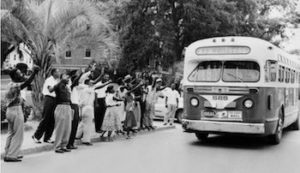
*On this date in 1956, the Tallahassee bus boycott began. This citywide boycott in Tallahassee, Florida, sought to end racial segregation in the city's transit employment and seating arrangements.
In the Jim Crow South, not only were buses segregated, with white riders at the front and Blacks in the back, but if there were no free Black seats, Black riders had to stand, even if there were free white seats. Furthermore, black riders had to surrender their seats if there were more white riders than white seats. Wilhelmina Jakes and Carrie Patterson, two Florida A&M University students, boarded a city bus and sat in the only open seats next to a white woman.
The driver declared that the two women could not sit where they were, and Jake agreed to get off the bus if she received her bus fare in return. The driver would not return Jake's bus fare and drove to a service station, where he then called the police, who arrested both women. Later that day, the Dean of Students intervened on behalf of the students.
The day after the incident, the Ku Klux Klan burned a cross in front of the women's residence. News of the cross-burning quickly spread throughout the campus, and Student Government Association officers called for a meeting of the student body. The incidents (the cross-burning and the arrest) were discussed in the meeting. Student leaders called for the withdrawal of student support from the bus company and urged students to participate in the boycott throughout the community.
Reverend C. K. Steele organized a mass meeting that night. In the meeting, the Inter-Civic Council (ICC) was born. Its leaders held weekly meetings, and the Council was highly active in civil rights-related activism. Three months into the boycott, the demand for hiring black bus drivers was met. That still led to the arrests of blacks who did not sit in the seats assigned to them. Efforts persisted in resisting bus segregation, and enforcement of the ordinance became less strict when blacks again rode the buses.
The NAACP became involved well after the boycott started when leaders sent a lawyer to defend drivers of boycotters (carpool drivers) who were arrested for driving unlicensed "for hire" vehicles. The Inter-Civic Council ended the boycott on December 22, 1956. On January 7, 1957, the City Commission repealed the bus-franchise segregation clause because of the United States Supreme Court ruling in Browder v. Gayle (1956). In 1959, members of the Tallahassee InterCivic Council tested the boycott's success by riding the newly integrated buses; they found that the integration was successful.
Sociologist Lewis Killian notes that organizational and community leaders did not gather until after the boycott was initiated, which underscores the spontaneity of the student-led boycott. The boycott presents an overlooked departure from the circumstances of the Montgomery bus boycott, which was planned and precipitated by active individuals and organizations; in addition, the Tallahassee boycott, at least in its initial stages, was separate from and did not model the latter.